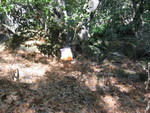Marin Camping Weekend
Camp Tamarancho
Date: Jun. 29 - 30, 2013
Location: Fairfax, CA
Event Director: - 415.456.8118
Course Setters: Bud Laird, Randy Franklin, Andrew Peterson
Type: C; 2-loop relay course for pairs and solos on Saturday, Scramble on Sunday
Saturday Course Setter's Notes
By
Courses
Course Length Climb Controls
Orange 3.5 km 200 m 13 Brown 3.0 km 165 m 13 Combined 6.5 km 365 m 26
The map scale is 1:10,000. The contour interval is 5 meters.
The Saturday courses are set so that individuals may choose to do one course, or combine the two courses into a single long course. Also, the two courses can be run as a two-person relay. The procedure is as follows:
- The individuals running the combined course have the first mass start. They will receive both maps (Orange and Brown courses), and begin their run on either course, their choice.
- Less experienced and (self decided) "more mature" runners will start later, in a second mass start, and will attempt either course. They will receive only the map for that course.
- A third mass start will be for any two-person relay teams, and for any late comers who missed one of the first two mass starts.
- The last two controls on both Orange and Brown (numbers 12 and 13 on each map) are the same for each course. Competitors doing one course will proceed from 13 to the Finish, as usual. Competitors doing the combined course will not proceed to the Finish from the last control on their first course (control 13), but will instead continue on to the first control for the next course from that point. On the second course, they will go to the Finish after punching controls 12 and 13 on that course.
Spectating
From a location about 15 meters from the start, there is an excellent viewing point that allows observation of the runners navigating the early and later parts of each course. There is direct observation of the activity to and between controls 12, 13, and the Finish, and those controls are set to hopefully give everyone a chance to observe the runners "duke it out" over both climb and flat terrain. Runners doing the combined course may pass through, or along the edge of the viewing area on their way to the first control of their second course, depending on route choice.
General Comments
In setting the courses, I tried to provide as many options as possible for the Orange course runners to use either trail/handrail routes or cross-country routes requiring a bit more navigation. Controls on this course tend to favor more easily discernible control features such as significant rocks, hilltops, and the like. The Brown course may present more navigational challenge, since some legs may require significant cross-country navigation and less point-specific features such as reentrants, or less easily discernible features such as pits. Although the Orange course is a little longer, with a bit more climb, I would think that the Brown course would present more of a challenge to the experienced orienteer.
The area is generously occupied by poison oak (PO). Anything marked as green on the map, even lightest green, should be considered a possible rendezvous with PO. Dark green should best be considered as wall-to-wall PO, either on the ground, in bush form, or hanging from the trees. White areas are less apt to be populated by PO, but you should be watchful for it in all of its forms. Yellow map areas are generally tall grass (shorter now), with occasional low-growing PO that is easily avoided. There is at least one direction of approach to every control that is either devoid of PO, or has easily avoided PO. There should be no reason to wade through the stuff when you are in close proximity to a control, although your particular route choice between controls (especially if you choose to go through areas marked green on the map) may bring you into contact, and you should address that as soon as possible after finishing. For those who are not familiar with what PO looks like, ask somebody and you can probably find some examples very close to the start area. When in doubt, if it's green, don't touch it.
Two symbols for control features are noteworthy:
- The × denotes a man-made structure.
- The bent-over arrow modifying the "tree" feature denotes a fallen, dead, ruined tree.
Although there are no areas of exceedingly steep slope that should be encountered, other than one 1.5 meter earth bank, I found that the collections of dead leaves and dried grass material made for some unsure footing on some of the hillsides. I did not encounter any other hazards while scouting the area.
The map does not show all of the available trails that may be of help in navigating between controls. Some trails that are marked on the map may be less obvious than indicated. Typically, there are more trails than less trails, probably due to the activity of the many groups who use the area. Competitors may benefit from vigilance in spotting trails, particularly in the white map areas, that might provide good micro route choices.
Enjoy!

